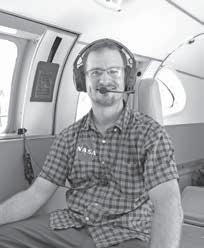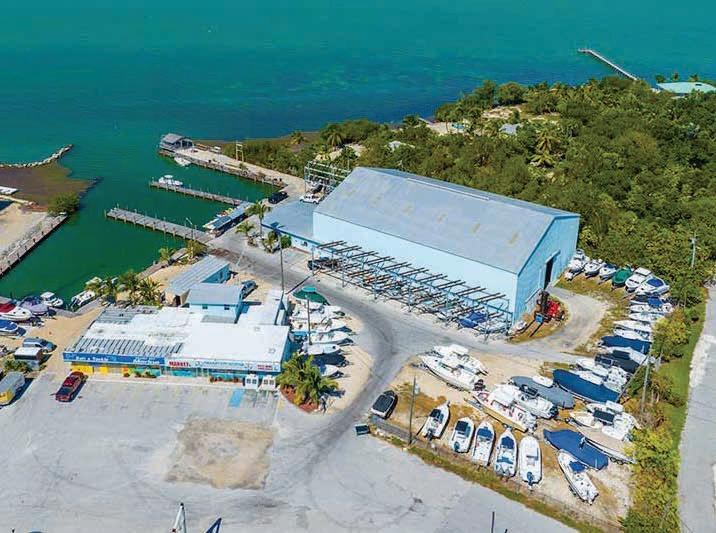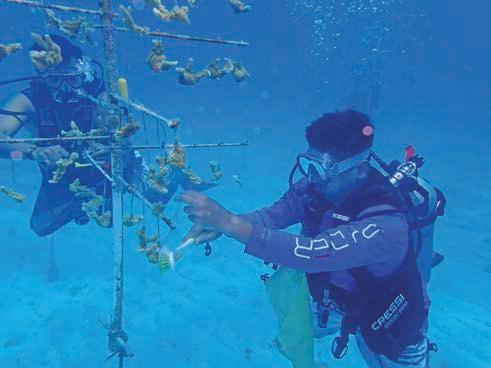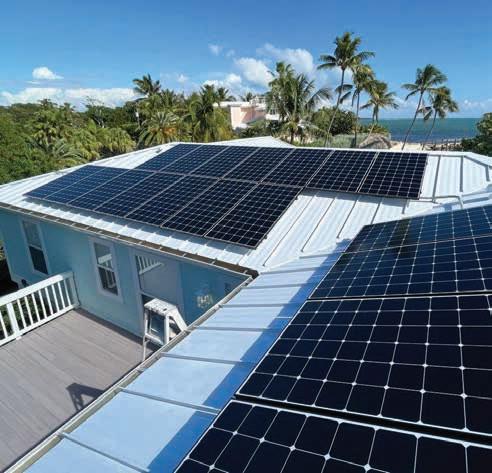
4 minute read
NASA CLIMATE PLANE VISITS KEYS FOR EARTH DAY
Aircraft flies over Everglades to measure greenhouse gas fluxes from mangrove ecosystems
TIFFANY
NASA, the History of Diving Museum, FIU and Coastlove celebrated Earth Day at Million Air in Marathon. The star of the show was a NASA climate plane that usually deploys over the Everglades to measure climate change. The N87Q was open to the public for touring, with NASA climate scientists giving tours inside and answering questions.
“This is the Blue Flux Flight Campaign,” said Ayia Lindquist, NASA’s climate change outreach and engagement coordinator at Goddard Space Flight Center near Washington, D.C. “We fly this plane 300 feet above the mangroves and we study the methane and carbon dioxide fluxes of the mangrove ecosystems to better understand the impact on our Earth’s climate.”

The studies represent the cutting edge of climate science in South Florida. “Mangroves withdraw or suck down a lot of CO2 (carbon dioxide) from the atmosphere to perform photosynthesis,” said NASA earth sciences research scientist Ben Poulter. “That CO2 makes its way down to the sediments of the mangrove soils, where this carbon becomes buried for hundreds and thousands of years. That sort of massive drawdown of CO2 from the atmosphere and the permanence of the burial of carbon makes mangroves a very attractive target for mitigating climate change and helping us lower CO2 concentrations in the atmosphere.”
In this way, mangroves help regulate our planet’s temperature. “What this does is help out our planet’s AC system – keeping it cool when we need it cool and warmer when we need it warm,” Lindquist said.
There’s a small catch that the scientists are studying: when mangroves store carbon, they release methane – another greenhouse gas that is 20 times more powerful than carbon dioxide but lasts half as long. “So, we’re really interested in understanding these fluxes between these gases,” Lindquist said, “and these science dynamics to better understand our planet.”

How does it work?
The plane is pretty small – carrying two pilots and one or two scientists, with gear. There are four instruments on board to study fluxes of methane and carbon dioxide emissions above mangroves.
“We fly 300 feet above the mangroves, which is pretty low,” said research physical scientist Glenn Wolfe. “We have to be pretty close to the surface to measure what’s happening – low enough to count the individual leaves on the trees if we need to.”
“It’s bumpy and hot, but there’s bluetooth to listen to music,” he added. “And, it’s a beautiful thing to see the Everglades from 300 feet. You see the whole area, and you know you’re doing science – it’s pretty great.”
The atmospheric measurement technique that Wolfe, Poulter and their colleagues use is called “eddy covariance.” It measures and calculates the vertical turbulent fluxes existing within atmospheric boundary layers. Put another way, it observes the exchange of gas, energy and momentum between ecosystems like mangroves and the atmosphere.
Only four or five groups in the world have the capability and expertise to carry out eddy covariance measurements from an aircraft. The NASA team is one of them, and they hope to complete two more missions over the Everglades by this time next year.
NASA also works with a field team that goes into the mangroves on foot to validate the measurements taken by the plane. The hope is eventually to include corresponding satellite data to get a much more comprehensive idea of the carbon budget of mangroves and the role they play in climate change regulation, Poulter said.
“So, what we’re trying to do with Blue Flux is collect more data, so we can actually understand how much CO2 is being taken out of the atmosphere by mangroves and wetland ecosystems in South Florida and how much methane is being produced,” Poulter said. “We have to keep that in mind when we restore and conserve these blue carbon ecosystems.”
The scientists estimate that methane production actually decreases the climate benefit of mangroves by 5% to 15%. “The pros outweigh the cons, but as things like sea-level rise and hurricane frequency cause mangrove die offs, that balance is going to fluctuate,” Poulter said.
In the end, the mission’s aim is to develop products to help understand the carbon cycle at any scale – from a stand of trees up to a full ecosystem, Poulter said. All of these will help to inform mangrove restoration and conservation efforts.
“Obviously, what's needed first is for us to move immediately and rapidly to renewable energies and stop burning fossil fuels,” he concluded. “But, in the meantime, natural ecosystems can help us buy time before we make that transition.”
To complement the tour of the plane and its mission, the History of Diving Museum has a new exhibit about the similarities between ocean and space exploration, and Coastlove held a simultaneous mangrove cleanup and planting.
Rebuilding The Reefs For Earth Day

Aquarium Encounters, Reef Renewal USA team up again for coral fragmenting

Helping to rebuild the Keys’ vital coral reef ecosystem fits the bill for Earth Day, and that was the goal on April 20-22 as Florida Keys Aquarium Encounters once again partnered with Reef Renewal USA and Captain Hook’s for a coral fragmentation workshop and coral nursery maintenance dives.
In a continuation of the partnership’s first Marathon event in September 2022, Reef Renewal, Aquarium Encounters and Captain Hook’s staff spent Thursday and Friday afternoon helping members of the public use band saws to cut larger pieces of boulder corals into smaller pieces. Known as fragmenting, the process accelerates the growth of the corals, allowing each coral to grow, cover the cement plug to which it is affixed, and eventually spawn earlier than it would otherwise. The fragments are typically ready to outplant on areas of the reef after six to 12 months spent in a nursery.
On Saturday, teams of divers headed out to the reefs off Marathon and Big Pine Key to return the fragmented corals to nurseries where they can grow undisturbed under close supervision. Volunteers also spent time cleaning coral trees and touring restoration sites to showcase the progress of already-outplanted corals.
— Alex Rickert



















